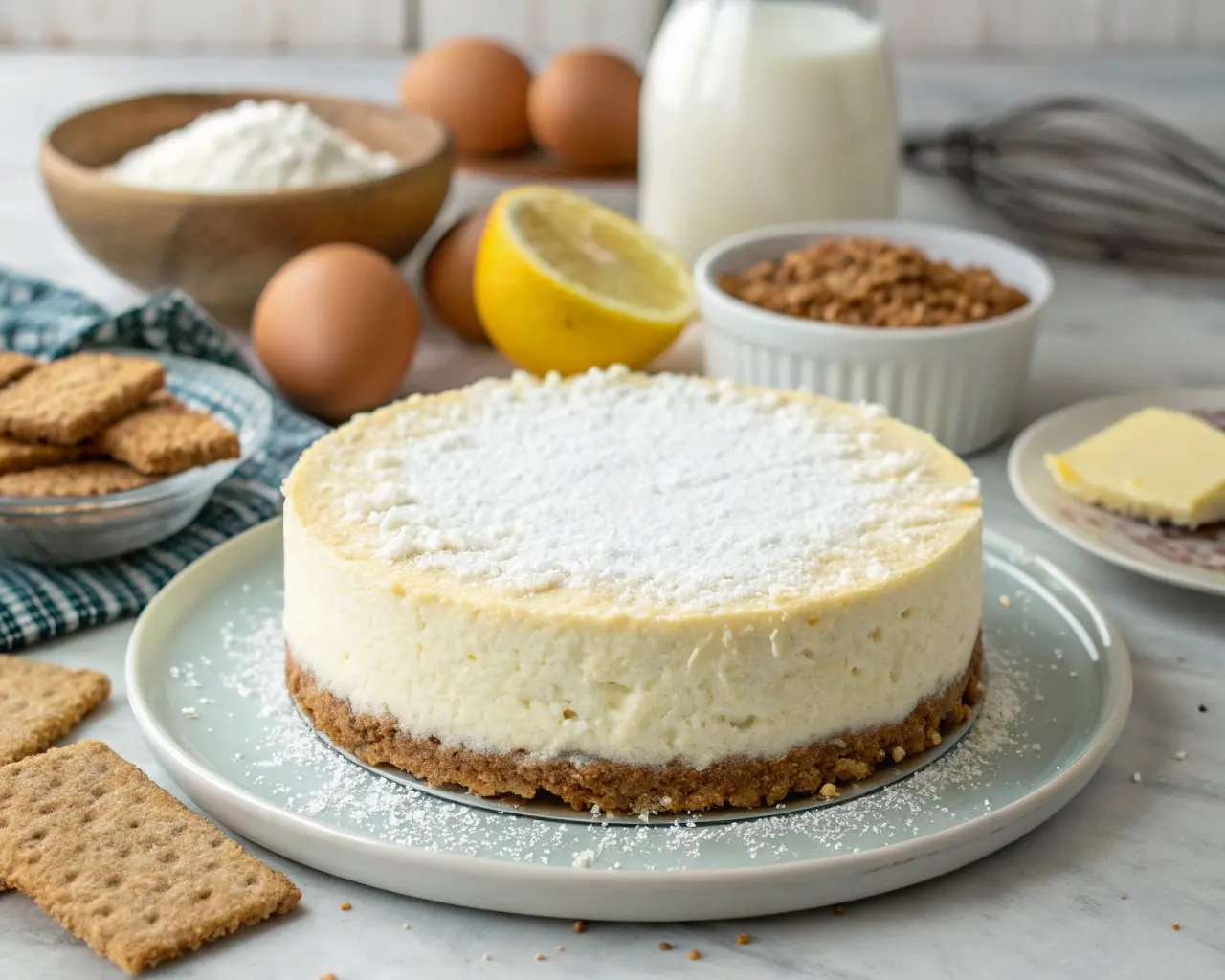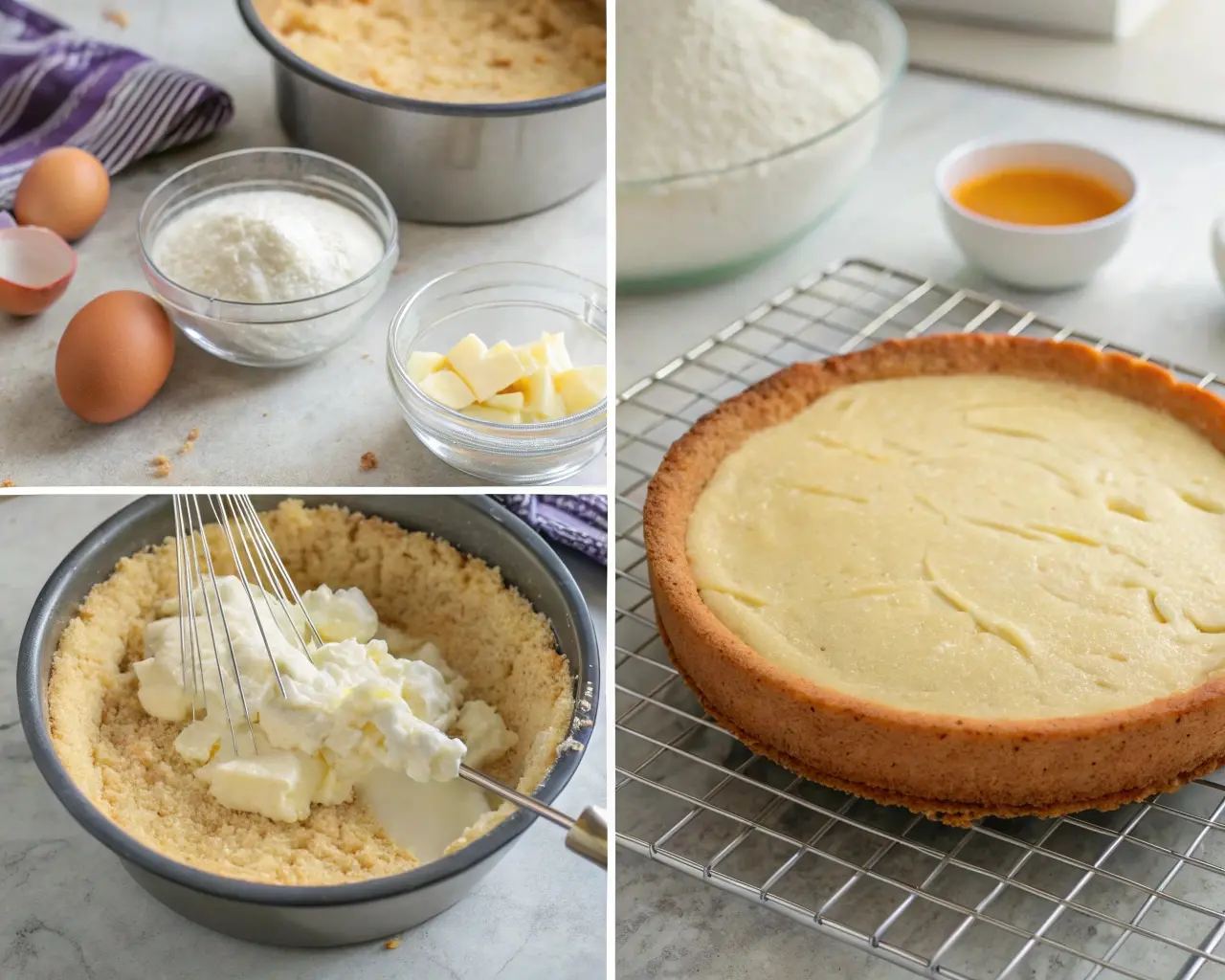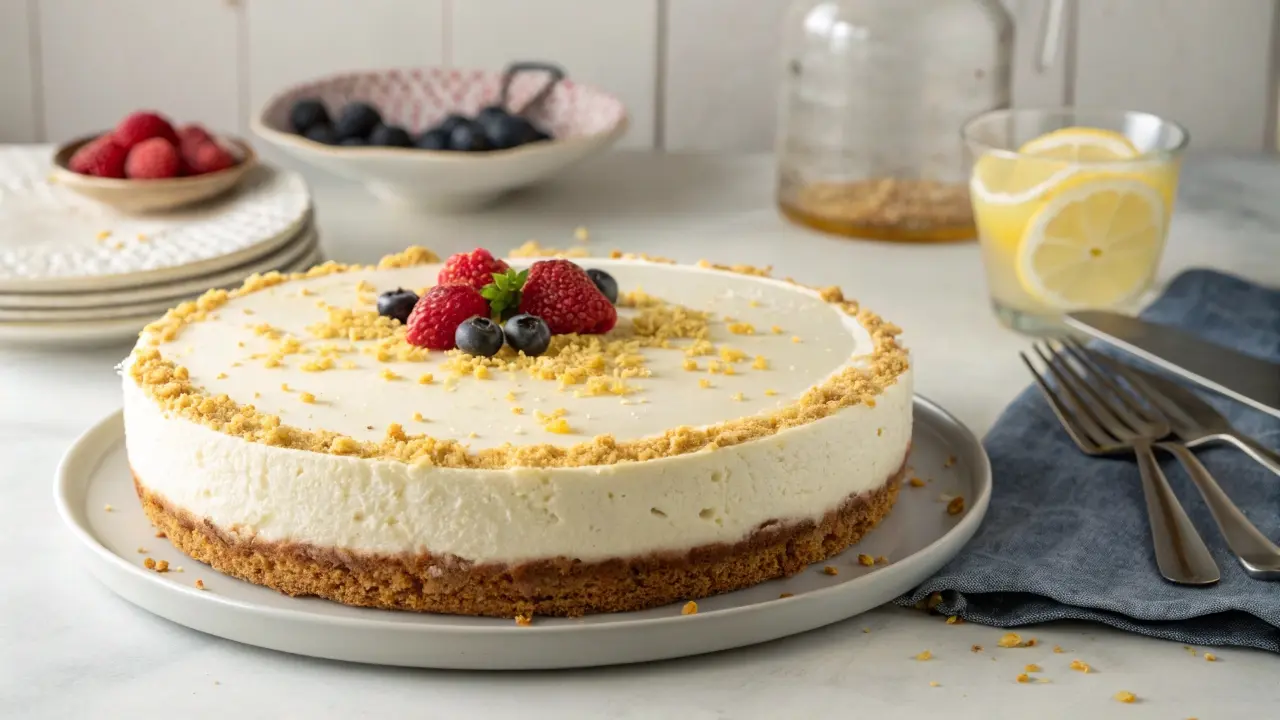Who doesn’t love a good cheesecake? But let’s be honest—sometimes that classic cream cheese version can feel a little too heavy. That’s where cottage cheese cake comes in! It’s lighter, packed with protein, and has a subtle tang that makes it absolutely irresistible.
In this guide, we’re diving deep into everything you need to know about making cottage cheese cake. Whether you’re a seasoned baker or a total newbie, you’ll find everything from the best variations to foolproof baking tips. We’ll even answer those burning questions like, “Can I swap cottage cheese for ricotta?” and “How do I keep my cheesecake from cracking?”
And don’t worry—this isn’t some dry, technical baking guide. We’ll keep things real with helpful shortcuts, funny kitchen fails (because we’ve all been there), and plenty of mouth-watering ideas. Ready? Let’s get baking!
Introduction to Cottage Cheese Cake
What is Cottage Cheese Cake?

Cottage cheese cake is exactly what it sounds like—a cheesecake made with cottage cheese instead of (or in addition to) cream cheese. The result? A lighter, slightly textured cake that still delivers that rich, creamy taste. Some versions lean into a fluffy, soufflé-like consistency, while others mimic traditional cheesecake but with a bit more bite.
Unlike regular cheesecake, which can be super dense, this one has a more delicate texture. Plus, cottage cheese brings in some major nutritional perks (we’ll get to that in a sec). If you’ve never tried it before, think of it as cheesecake’s healthier, high-protein cousin.
Historical Background and Origins
Believe it or not, cottage cheese cake has been around for centuries! Many European countries have their own take on it. In Germany, they call it Käsekuchen, where it’s often baked with a shortcrust base. Russians love their version, Zapekanka, which is usually served for breakfast (because, hey, why not start your day with cake?). Over in Sweden, you’ll find strawberry-topped varieties that are absolute showstoppers.
Even in the U.S., where New York-style cheesecake reigns supreme, more and more people are giving cottage cheese cake a shot. Whether it’s for the health benefits or just the taste, this twist on cheesecake is definitely making a comeback.
Nutritional Benefits of Using Cottage Cheese in Baking
Now, let’s talk about why swapping out cream cheese for cottage cheese is a total game-changer:
- More Protein, Less Guilt – Cottage cheese is packed with protein, making this dessert a sneaky way to get some extra nutrients.
- Lower in Fat – Traditional cheesecake can be a calorie bomb. Using cottage cheese cuts down on the fat while still keeping things creamy.
- Calcium for Strong Bones – You’re basically doing your bones a favor by eating this cake. (Okay, maybe that’s a stretch, but still…)
- Naturally Lower in Sugar – Unlike store-bought cheesecakes, which are loaded with added sugar, this version can be naturally sweetened with honey or fruit.
So if you’ve been looking for a way to enjoy cheesecake without the usual food coma, cottage cheese cake might just be your new favorite dessert.
Popular Variations of Cottage Cheese Cake
There’s no one way to make cottage cheese cake, and that’s the beauty of it! Depending on where you are in the world, you’ll find different takes on this creamy, protein-packed dessert. Some versions stick to the traditional cheesecake vibe, while others go all in on fresh fruit, nuts, or even chocolate.
Here are a few delicious variations that you might want to try at home.
Traditional German Cottage Cheese Cake
Germany is serious about its cheesecakes, and their Käsekuchen is proof. Unlike the super-rich New York-style cheesecake, this one is light, airy, and sometimes made without a crust. Cottage cheese cake in Germany is typically baked with quark, a fresh dairy product similar to cottage cheese but smoother. Since quark isn’t always easy to find, blended cottage cheese works just as well.
- The crust is usually a simple shortcrust pastry, which gives it a firmer base than the classic graham cracker crust.
- It’s lightly sweetened, often with vanilla and lemon zest for extra flavor.
- Some versions include raisins (love ‘em or hate ‘em), which add a little chewiness.
If you prefer a less sweet cheesecake with a more delicate texture, the German-style cottage cheese cake is a must-try!
Swedish-Style Strawberry Cottage Cheese Cake
Swedes love their cakes light and fruity, and their cottage cheese cake is no exception. This variation is usually served with fresh strawberries and a dollop of whipped cream—perfect for warm summer days.
- The filling is softer and fluffier than traditional cheesecake, often whipped to incorporate air.
- Fresh strawberries (or raspberries) are baked into the cake or served on top.
- A touch of cardamom gives it a unique Nordic twist.
If you like your cheesecake with a fresh, fruity touch, this version is for you.
Cottage Cheese Blueberry Breakfast Cake
Yes, cottage cheese cake for breakfast is a thing! If you love muffins or coffee cake, this one will hit the spot.
- The base is made with a light cake batter instead of a dense cheesecake filling.
- It’s packed with blueberries, which add a natural sweetness.
- A touch of honey makes it sweet but not too sugary—a great alternative to store-bought pastries.
This is perfect for meal prep since it keeps well in the fridge for a few days. Grab a slice in the morning with coffee, and you’re good to go!
Health Benefits of Cottage Cheese in Cakes
Alright, let’s talk health benefits. If you’re trying to make smarter dessert choices, cottage cheese cake is a great way to cut back on fat and sugar without giving up on flavor. Plus, it’s loaded with nutrients that your body will actually appreciate.
High Protein Content
Most cheesecakes rely on cream cheese, which is delicious but not exactly protein-packed. Cottage cheese, on the other hand, is a protein powerhouse! A single slice of cottage cheese cake can have twice the protein of regular cheesecake, making it a great choice if you want a filling treat.
- Protein helps keep you full longer, so you won’t be reaching for another snack 20 minutes later.
- It’s great for muscle recovery, especially if you’re into fitness.
Lower Fat Compared to Traditional Cheesecakes
We all love cheesecake, but let’s face it—most recipes are loaded with butter and full-fat dairy. Swapping cream cheese for cottage cheese can significantly cut down the fat and calorie count while keeping things creamy.
- Full-fat cream cheese has about 10 grams of fat per serving, while cottage cheese has around 4 grams.
- Lower fat doesn’t mean less flavor! When mixed with honey, vanilla, or citrus, cottage cheese cake tastes just as indulgent.
Rich in Essential Nutrients
Beyond just protein, cottage cheese is packed with calcium, B vitamins, and probiotics—all of which are great for your health.
- Calcium strengthens bones and keeps your teeth in top shape.
- B vitamins boost energy and help your body function better.
- Probiotics support gut health, making digestion a little smoother.
So, while this is still a dessert, it’s one you can enjoy without feeling guilty. Win-win!
Step-by-Step Guide to Making a Classic Cottage Cheese Cake

Now, let’s get to the fun part—baking! A cottage cheese cake isn’t just easy to make; it’s also super forgiving. Unlike regular cheesecake, which can be a little temperamental (hello, cracked tops!), this one is much more foolproof.
Below is a simple yet delicious recipe for a classic cottage cheese cake. It has a slightly tangy flavor, a creamy texture, and just the right amount of sweetness.
Ingredients Needed
For the crust:
- 1 ½ cups crushed graham crackers or digestive biscuits
- ¼ cup melted butter
- 2 tbsp sugar
For the filling:
- 2 cups cottage cheese (blended until smooth)
- ½ cup Greek yogurt (adds creaminess)
- 3 eggs
- ½ cup honey or sugar
- 1 tsp vanilla extract
- 1 tbsp lemon zest
- 2 tbsp cornstarch (helps with texture)
Preparation of the Crust
- Preheat your oven to 325°F (160°C) and grease a 9-inch springform pan.
- In a bowl, mix the graham cracker crumbs, melted butter, and sugar until it looks like wet sand.
- Press the mixture into the bottom of the pan, making sure it’s even.
- Bake for 10 minutes, then let it cool while you prep the filling.
Creating the Cottage Cheese Filling
- Blend the cottage cheese in a food processor or blender until completely smooth. (Trust me, this step makes all the difference.)
- In a large bowl, whisk the eggs, sugar, and vanilla until combined.
- Add in the blended cottage cheese, Greek yogurt, lemon zest, and cornstarch, mixing until smooth.
Baking Instructions
- Pour the filling over the cooled crust, smoothing out the top with a spatula.
- Bake for 40-45 minutes, or until the edges are set but the center has a slight jiggle.
- Turn off the oven and let the cake cool inside for 30 minutes with the door slightly open (this helps prevent cracks).
Cooling and Serving Tips
- Once cooled, refrigerate for at least 4 hours, preferably overnight.
- Before serving, top with fresh berries, honey drizzle, or a dusting of powdered sugar.
- Slice, serve, and enjoy your homemade cottage cheese cake!
For more delicious recipes, check out our latest recipe articles.
Tips and Tricks for the Perfect Cottage Cheese Cake
Even though cottage cheese cake is easier than traditional cheesecake, a few small tweaks can make a huge difference in flavor and texture.
Choosing the Right Type of Cottage Cheese
Not all cottage cheese is created equal! Some brands have a grainier texture, which can make the cake a bit lumpy. Here’s what to do:
- Always blend the cottage cheese until smooth. This gives the cake a creamier consistency.
- Use full-fat cottage cheese if you want a richer taste. Low-fat works too, but it won’t be as decadent.
Enhancing Flavor with Add-ins
Want to jazz up your cottage cheese cake? Try these easy add-ins:
- Vanilla bean or almond extract for a deeper flavor.
- Chopped nuts or chocolate chips for extra texture.
- Fresh fruit (like raspberries or peaches) mixed into the batter.
Common Mistakes to Avoid
- Skipping the blending step – Unblended cottage cheese can make the filling too grainy.
- Overbaking – The center should still jiggle slightly when you pull it out.
- Not chilling long enough – Cheesecake tastes way better after a night in the fridge.
Creative Toppings and Serving Ideas
A cottage cheese cake is delicious on its own, but let’s be honest—toppings can take it to a whole new level. Whether you’re looking for something fruity, chocolatey, or crunchy, there’s a topping for you.
Classic and Fruity Toppings
If you love a refreshing, tangy contrast to the creamy texture of cottage cheese cake, try these:
- Fresh berries – Strawberries, blueberries, raspberries, and blackberries add natural sweetness and color.
- Citrus zest & honey drizzle – A touch of orange or lemon zest plus honey gives a bright, refreshing flavor.
- Fruit compotes – Simmer chopped fruits like apples, cherries, or peaches with a bit of sugar for a homemade jammy topping.
Indulgent and Decadent Toppings
Want something a little richer? These will make your cheesecake feel extra special:
- Chocolate ganache – Melted dark chocolate and heavy cream = pure heaven.
- Caramel sauce & toasted pecans – Sweet, sticky caramel with crunchy nuts is always a win.
- Crushed cookies or granola – A little crunch adds texture and makes every bite more exciting.
Savory & Unique Twists
Feeling adventurous? Try these unexpected yet delicious toppings:
- Greek yogurt & a drizzle of maple syrup – Adds a tangy, slightly sweet contrast.
- Toasted coconut flakes – A tropical spin that pairs beautifully with citrus flavors.
- A sprinkle of sea salt – A pinch of flaky salt on caramel or chocolate toppings enhances the sweetness.
No matter how you top it, your cottage cheese cake will be a showstopper. Experiment with different combinations and find your favorite!
Storage and Make-Ahead Tips
Got leftovers? No problem! Cottage cheese cake stores surprisingly well, so you can enjoy it for days without losing flavor or texture.
How to Store Cottage Cheese Cake
- Refrigerator: Keep your cheesecake in an airtight container for up to 4–5 days. If it’s sliced, cover each piece with plastic wrap to prevent it from drying out.
- Freezer: Want to save some for later? Wrap slices individually in plastic wrap, then place them in a zip-top freezer bag. They’ll stay fresh for up to 2 months!
Best Way to Reheat or Serve Leftovers
- Straight from the fridge: Let it sit at room temperature for 10–15 minutes before serving for the best texture.
- From frozen: Thaw in the fridge overnight. Avoid microwaving, as it can make the texture rubbery.
Can I Make Cottage Cheese Cake Ahead of Time?
Absolutely! In fact, cheesecake tastes even better the next day because the flavors have time to develop. If you’re making it for an event, bake it at least one day in advance and store it in the fridge until ready to serve.
Now that you’ve got the full breakdown, it’s time to whip up your own cottage cheese cake! Don’t forget to try different flavors, get creative with toppings, and enjoy every bite.
Frequently Asked Questions (FAQs)
Baking a cottage cheese cake is pretty straightforward, but a few common questions always pop up. Let’s clear them up!
Can I Substitute Cottage Cheese with Ricotta in Cheesecake Recipes?
Yes, but with some tweaks. Cottage cheese is slightly tangier and has more moisture than ricotta, so if you swap it, the texture might change. If you’re using ricotta: • Blend it super smooth to mimic cottage cheese. • Add a little extra yogurt or milk to compensate for dryness. • Expect a denser cheesecake since ricotta is naturally thicker.
How Do I Prevent My Cottage Cheese Cake from Cracking?
Nobody wants a cracked cheesecake! Here’s how to avoid it: • Don’t overmix the batter—too much air causes cracks. • Bake it low and slow (325°F is perfect). • Let it cool in the oven with the door slightly open before refrigerating.
Is It Necessary to Blend the Cottage Cheese for a Smoother Texture?
Absolutely! If you skip this step, your cheesecake might end up grainy. Blending breaks down curds, giving you that rich, creamy filling that’s key to a great cottage cheese cake.
For more baking tips, check out our latest recipe guides.
Conclusion
And there you have it—your ultimate guide to making a delicious cottage cheese cake! Whether you go for the classic version, a fruity twist, or a breakfast-friendly option, this cheesecake is a game-changer. It’s lighter, packed with protein, and easier to make than traditional cheesecake.
So why not give it a try? Grab some cottage cheese, whip up a batch, and enjoy a guilt-free slice of creamy goodness. And if you loved this recipe, don’t forget to check out more of our sweet and savory baking ideas. Happy baking!



